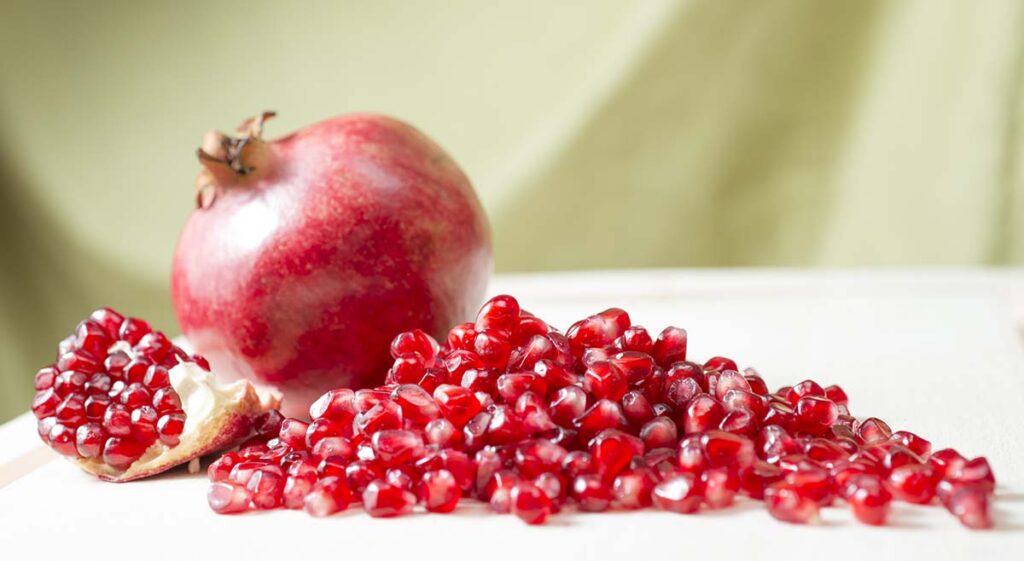
We may receive commissions from purchases made through links in this post, at no additional cost to you.
The thing that makes pomegranates so delicious, in my opinion, is the balance of sweet and tart. If you’ve only tasted a pomegranate from the grocery store (or juice from a bottle), you’re in for a surprise – the flavor of homegrown pomegranates is so much more intense and nuanced than those sitting in the store for days or weeks.
But what if your backyard pomegranates’ flavor is disappointing? It takes about seven months for a young pomegranate to mature on the tree. That’s a long time to wait for fruit that’s more sour than sweet. So what can you do to grow sweeter pomegranates?
Pomegranate sweetness is improved by soil health, sun exposure, variety selection, tree maturity, and cultural practices. Simple changes to watering habits, harvest time, pruning, and fertilizing can help correct overly tart pomegranates.
The following are some easy things you can do to grow the sweetest, most flavorful pomegranates possible. Who knows – this might be so successful that you need to make room for a couple more pomegranate trees!
Provide the Right Environment
The amount of sun and water a pomegranate tree receives will directly impact how flavorful the fruit becomes. If you situate the tree in a good location, it will have an easier time getting the right exposure to light and moisture.
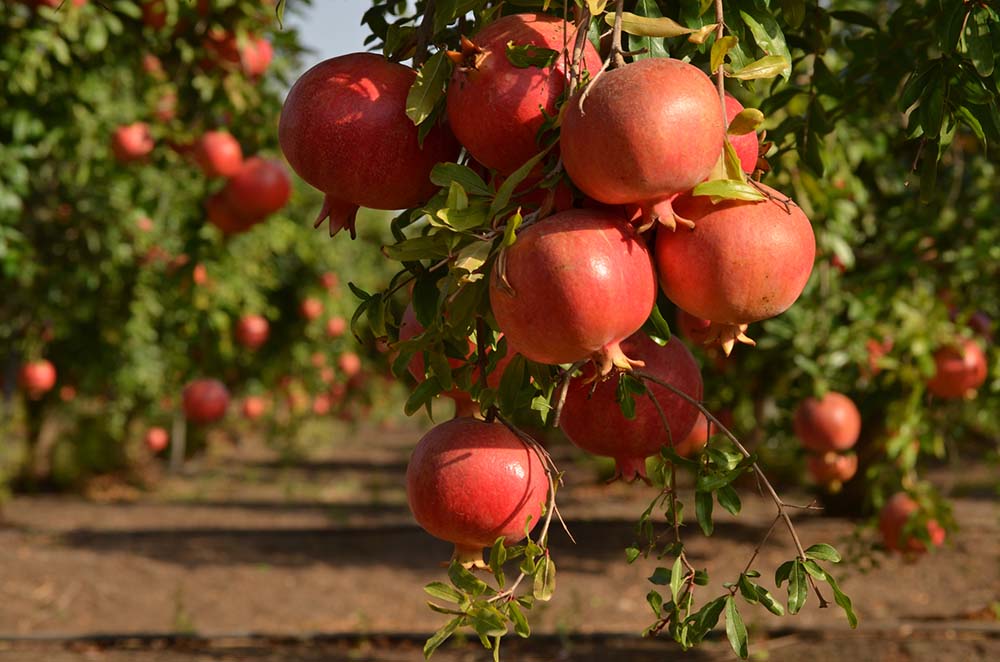
Light
Sunlight plays a key role in how sweet pomegranates grow to be. Light is the energy behind photosynthesis, the process in which the plant converts water and carbon dioxide into sugars. Those sugars are then used as energy for all kinds of processes, including developing fruit quality.
The sugars created through photosynthesis are stored all over the pomegranate tree, including in the fruits themselves. Although the green skin of young fruits can create sugars on their own, fruit mostly serves as a receptacle for sugars formed by surrounding leaves (source).
In other words, it’s crucial that enough light reaches not only the whole pomegranate tree, but the branches and leaves near developing fruits. The best way to do this is to plant the tree in a spot that gets at least 6 hours of direct sunlight per day.
Many pomegranate varieties can tolerate some shade, but if there is too much, the pomegranates won’t be as sweet.
Water
It may seem obvious to state that water is essential for growing fruit, but there’s a little more to it than that. Pomegranate trees can handle periods of drought without getting too stressed. However, they will take up water rapidly when it’s available.
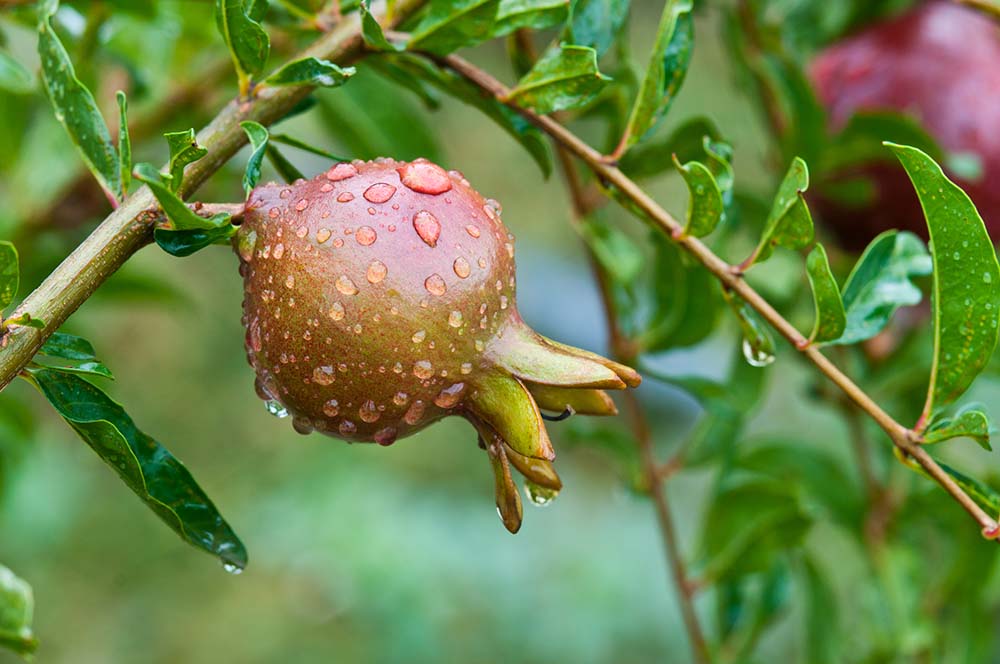
This can cause all kinds of problems – particularly fruit cracking. But taking up too much water toward the end of the season could also affect how sweet the pomegranates taste.
Related: Split Pomegranates? Why Splitting Happens and How to Stop It
Water pomegranate trees regularly while flowering and fruiting in the spring and summer. But later in the fall, when it’s getting close to harvest time, be careful not to over-water. Watering too much in the fall, once the pomegranates have reached their full size, could result in a watered-down flavor. Restricting the water a little will concentrate the sugars in the fruit.
Learn more about how to water pomegranate trees here: Parched Pomegranate Tree? How to Water it Well
Improve the Soil
The soil a tree is planted in has to provide pretty much everything the tree needs (other than light and water…although the soil has to be able to store moisture for the roots to access). If your soil is lacking in nutrients, microbial life, or has poor drainage, then that will have an affect on everything, including fruit sweetness.
For pomegranate trees, better soil health will result in sweeter, better tasting pomegranates. To find out what your soil might be lacking, perform a soil test. You can use a simple soil test kit like this one on Amazon to find out the basic pH level and macronutrient content. But if you need more details, I highly recommend a soil testing service such as SoilKit.
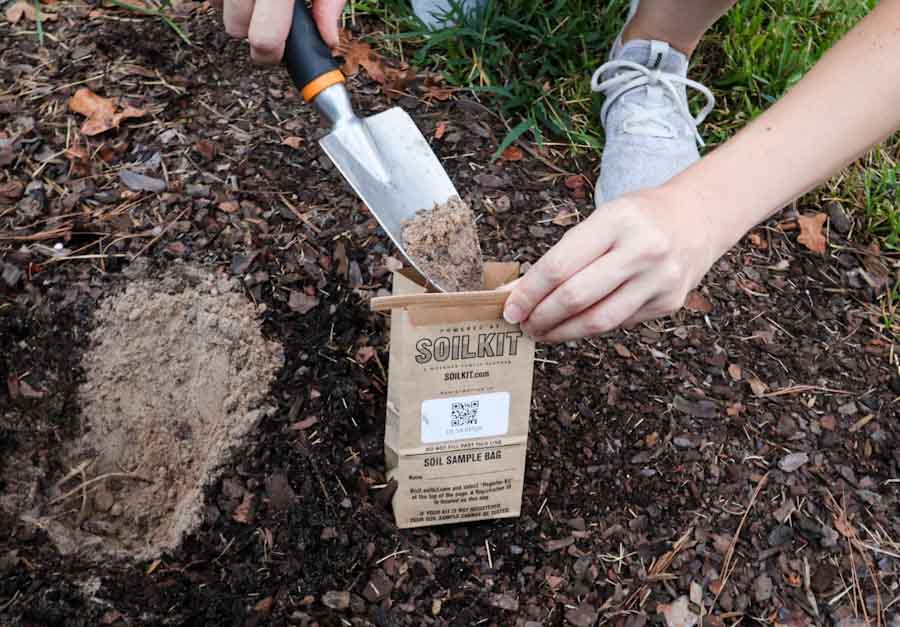
SoilKit is an easy-to-use, affordable mail-in service, and the results come with specific seasonal recommendations to amend your soil. (I am not an affiliate for them, but I used SoilKit in my own garden and highly recommend it! )
Once you have an idea of what the soil is lacking, you can take steps to fix the problem. Here are a few ways to improve the soil around your pomegranate tree.
Adjust pH
Soil pH is how acidic or basic the soil is. It’s measured on a scale of 0-14, with 7 being neutral. The lower the number, the more acidic. Higher numbers indicate less acidity, or more basic.
The pH has to do with how many Hydrogen ions are present in the soil. Acidic soil has a higher concentration of Hydrogen ions, alkaline soil has less. If the soil has too low or too high a pH, then minerals cannot dissolve, which means they can’t be made available to plant roots.
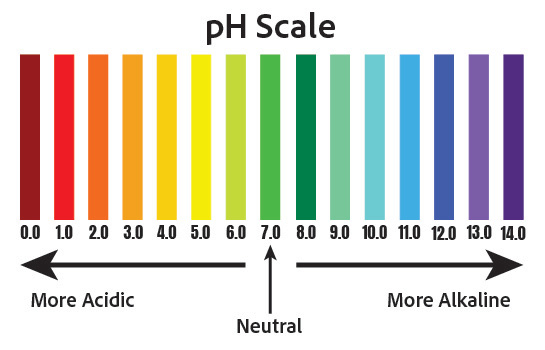
What does this mean for pomegranate trees? If the pH is out of the acceptable range for pomegranate trees (about 5.5 to 7.0), then the tree cannot uptake the nutrients it needs. This leads to nutrient deficiencies, which can affect everything from leaf color to fruit formation. In other words, inadequate nutrient uptake equals less flavorful fruit (and other problems).
If your soil is too acidic (below 5.5), the simple solution is to add garden lime to the soil. Lime not only neutralizes acidity, but it adds essential micronutrients such as calcium and magnesium. Follow the package instructions to figure out how much to apply.
It’s harder to adjust soil that is too alkaline, but adding a layer of compost can help slightly acidify soil over time. Luckily, pomegranates can tolerate a mild amount of alkalinity (up to about 7.5). You can also apply a soil acidifier that contains elemental sulfur. You will have to re-apply periodically as the results of this type of amending tend to be temporary. Again, follow package instructions precisely.
Add Organic Material
Adding well-decomposed compost, manure, shredded leaves, pine bark, worm castings, or other organic material will have a significant impact on the overall health of the pomegranate tree and its fruit.
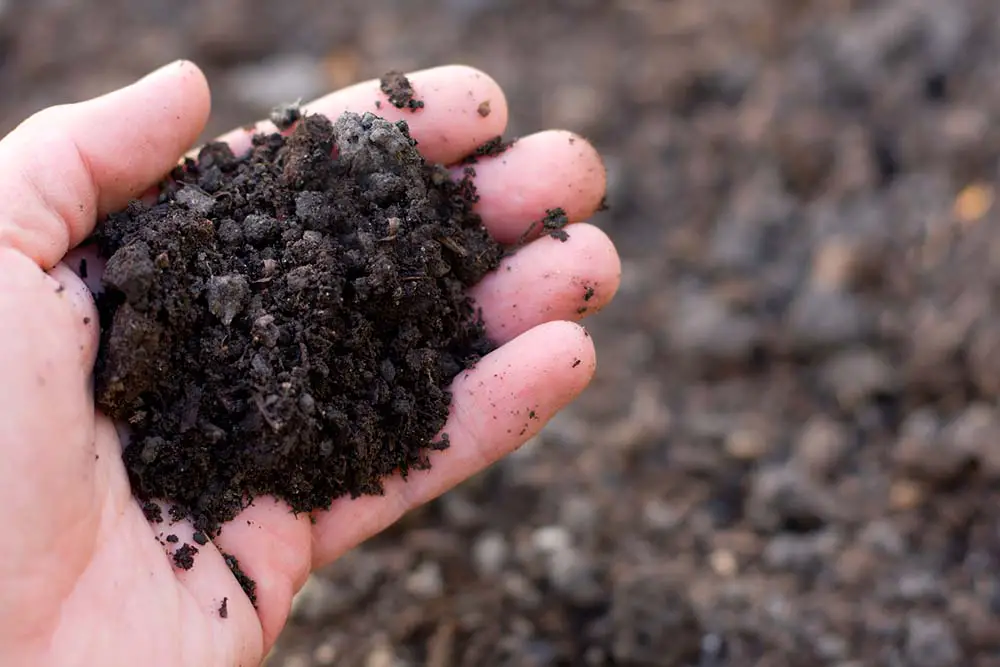
Organic matter, which has been defined as “living, dead, and very dead” material, improves soil structure, feeds beneficial microbial life, and provides essential nutrients to plants. Add a layer of compost around an already-planted tree, and it will feed the soil over time. And happier soil leads to sweeter pomegranates.
Improve Drainage
Pomegranate trees need consistent soil moisture, but they hate soggy soil. When the soil stays saturated for a long time after irrigation or rainfall, it keeps oxygen from getting to the roots. Airflow is an essential part of root health, as it allows water and nutrients to move through the soil and be absorbed by the plant. Without oxygen, the roots will literally suffocate.
When pomegranate trees don’t get the nutrients they need because the roots don’t have adequate oxygen, the fruit quality suffers. If the drainage problem persists, it could lead to root rot, fungal disease, and tree death.
The best thing you can do for bad drainage is move the tree to a spot with more freely-draining soil. When planting in a new site, dig in plenty of organic material such as compost and pine bark to improve the soil. Planting a pomegranate tree on a mound of soil above ground level will also keep the root system from getting waterlogged.
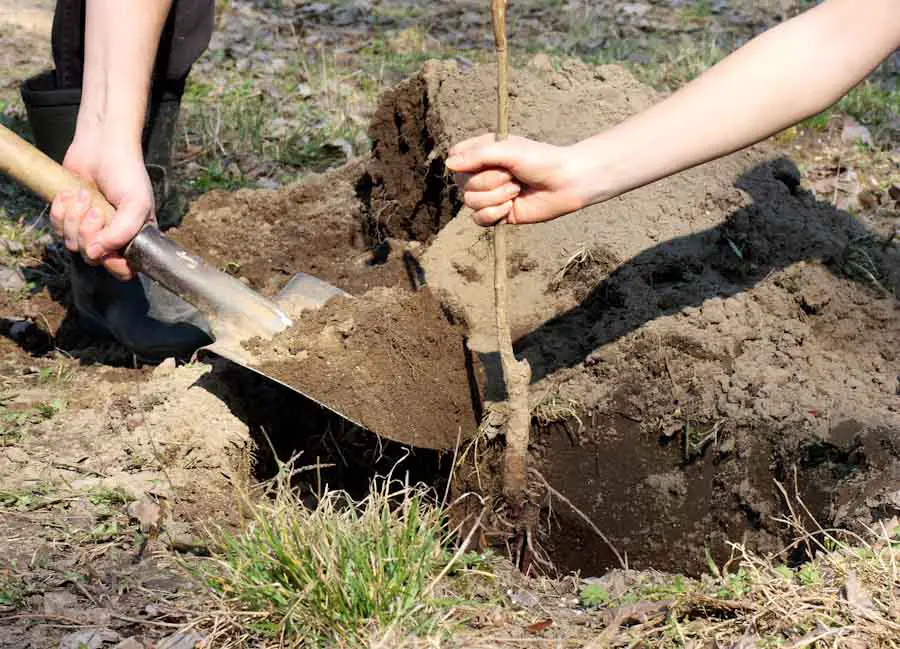
For more ideas and information about improving soil drainage, check out: Soil Drainage for Fruit Trees: Everything You Need to Know.
Thin Fruit and Prune Yearly
It’s painful to remove healthy, lush growth or young developing fruits from a tree, but often that is exactly what is needed to improve fruit quality. Yearly pruning and a little bit of fruit thinning are simple ways to grow sweeter pomegranates.
Pomegranate Pruning
Most pomegranate trees are pruned into a multi-stemmed tree, with 3-5 main trunks that split into branches. If left to its own devices, a pomegranate tree tends to grow shrubby and a bit wild, with lots of long shoots coming from the base of the plant.
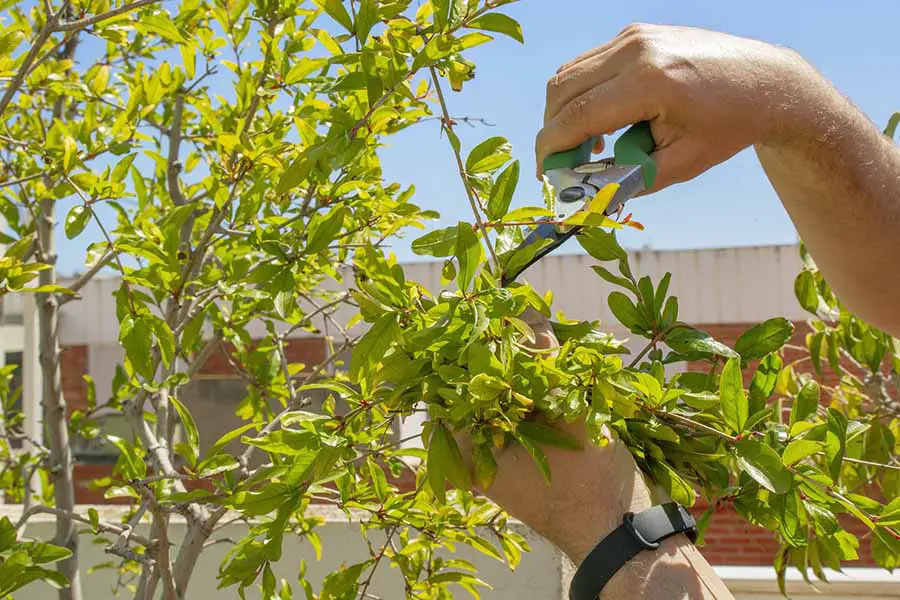
Selective pruning and shaping helps the plant have more energy to put toward developing fruit. An unpruned (or rarely-pruned) pomegranate tree will likely grow smaller, less flavorful pomegranates. To maximize sweetness, some simple trimming may be all that’s needed:
- When the tree is young, at the end of its first winter in the ground, choose which 3-5 trunks to keep, then prune the rest all the way to the ground. (Or, if you are pruning into a single-trunk shape, choose 3-5 scaffold branches and prune the rest back to the main trunk). Shorten each of those shoots by about 1/3.
- As the tree grows during the spring and summer, trim any root suckers or shoots that try to come up from the base of the plant. This will cause the scaffold branches to strengthen and grow thicker.
- Each following winter, remove any extra root suckers and damaged branches. Thin out anything growing too close together, especially toward the center of the plant. Light needs to reach every branch for the sweetest pomegranates possible, so thinning out dense growth is key.
These are the basic pruning steps, but you’ll find more details in: Pruning Pomegranate Trees: An Easy Guide for Home Growers.
Fruit Thinning
Pomegranates blossom and fruit in clusters primarily near the tips of branches. If there are too many pomegranates on a tree, or too many in a cluster, each fruit will receive a smaller share of a plants fruiting energy.
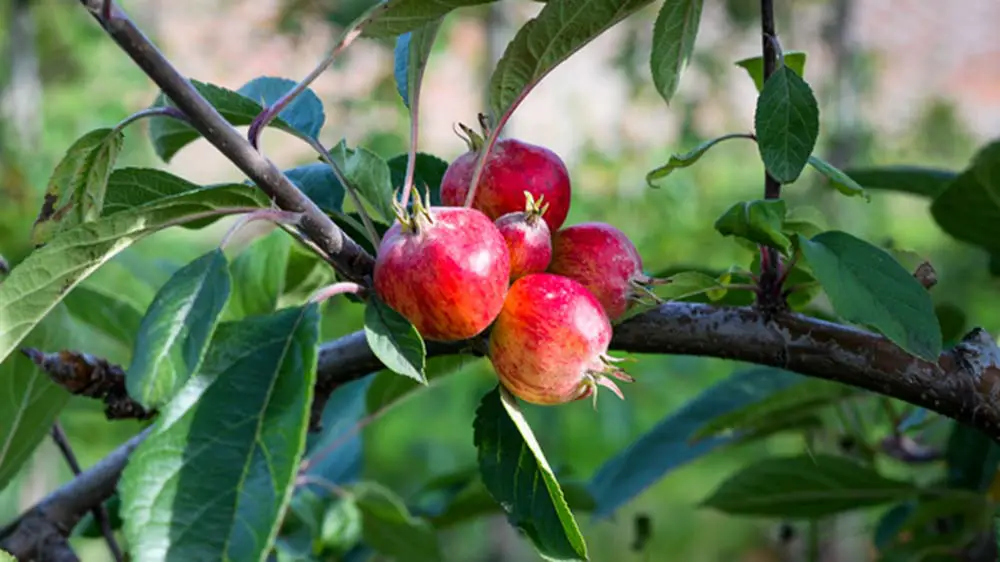
But if you thin out the fruit a little, the remaining pomegranates will grow bigger, sweeter, and more flavorful. The tree has limited nutrient resources, so if those resources are spread too thinly, it could result in fruit that is small, less juicy, or more tart than sweet.
The pomegranate tree itself will do a good amount of self-thinning. It will drop blossoms and young fruits that it cannot support, either because the tree is stressed, or because it doesn’t have enough energy to go around.
But it can still be helpful for a gardener to hand-thin young fruits on overly laden branches or clusters. A 2020 study found that thinning pomegranates by about 20% increased fruit size, weight, and quality. Aim to have the pomegranates spaced about 6 inches apart along the branch.
Provide the Right Nutrients
Nutrient availability is largely related to soil health, as we discussed above. Pomegranate trees usually don’t need much fertilizing, so before you reach for the fertilizer bag, double check your soil’s pH and drainage and make those adjustments first.
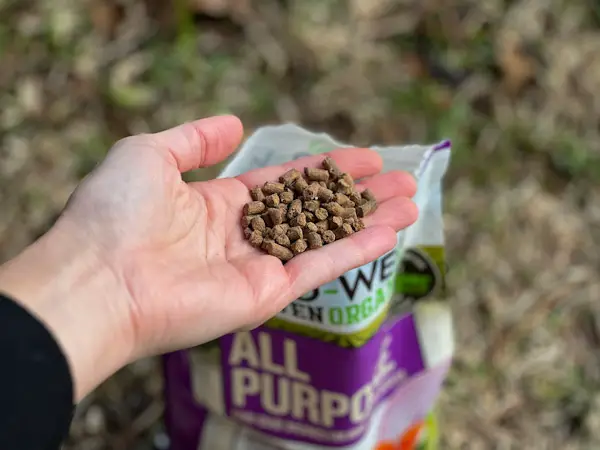
Certain nutrients are essential to pomegranate production and quality. Adequate potassium, in particular, is necessary for fruit size and flavor. A lack of potassium can result in pomegranates with discolored arils and less sweetness.
Nitrogen helps with healthy foliage growth and is an important part of photosynthesis. As discussed above, photosynthesis doesn’t just impact the green leaves, but also supports fruit development. A nitrogen deficiency will affect the overall growth of the plant (you may notice the plant looks pale) and the amount and quality of fruit.
Micronutrients also have a big impact on overall plant health and fruiting, especially calcium, boron, manganese, sulfur, and zinc. Choose a fertilizer that contains these micronutrients for best results.
The best fertilizers for pomegranate trees contain either a balanced NPK ratio (the proportion of nitrogen, phosphorus, and potassium in the fertilizer), or one with slightly more potassium than nitrogen. Organic fertilizers tend to provide more micronutrients and beneficial organic matter.
One of my favorites is the Jobe’s Organics 3-5-5 Fruit & Nut Granular Fertilizer, which also includes calcium, magnesium, and zinc. Another good option is Espoma Organic Citrus-tone 5-2-6 Fertilizer, which contains calcium, magnesium, and sulfur. Both of these products have a good amount of potassium balanced with nitrogen, which is essential for optimum fruit quality.
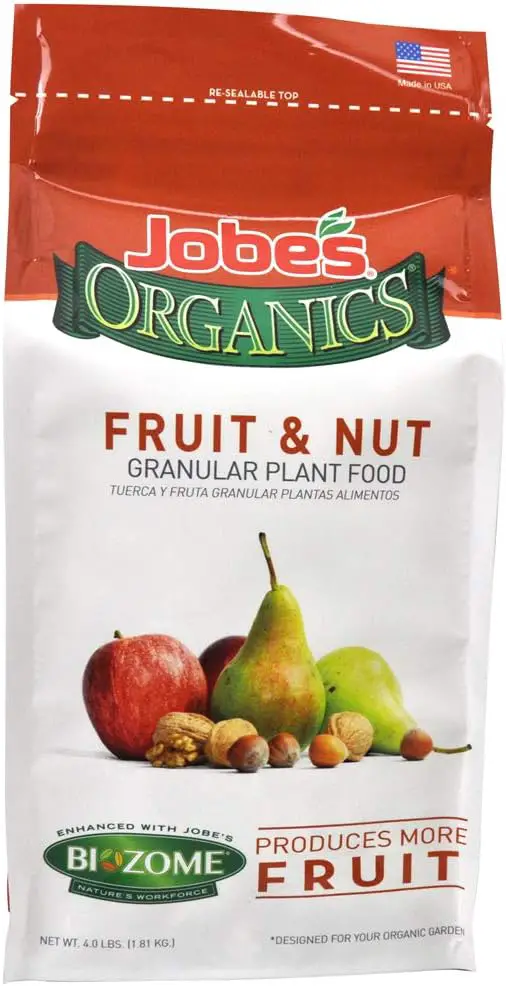
Bottom line: Healthy soil is the best way to ensure your pomegranate trees get the nutrients they need to grow the best-tasting fruit. But, fertilizer can help, especially if you have very sandy, lean soil.
Less is often more when it comes to fertilizing. Fertilize once in the early spring as growth is just beginning, then possibly once or twice more throughout the growing season. It may take some experimentation to find out what works best for your plant. Don’t fertilize after August, so the plant can start winding down for winter after the harvest.
Harvest at the Ideal Time
It can be challenging to know exactly when a pomegranate is ready to be picked. Color is not a good indicator of ripeness, as pomegranates turn their final color long before they are done growing.
Pomegranates harvested too early will be tart and somewhat dry. The longer the fruit sits on the tree, the more time it has to develop sugars and for the arils to swell up and become juicier. If you wait too long, however, the pomegranate may rot, split, or start fermenting on the tree.
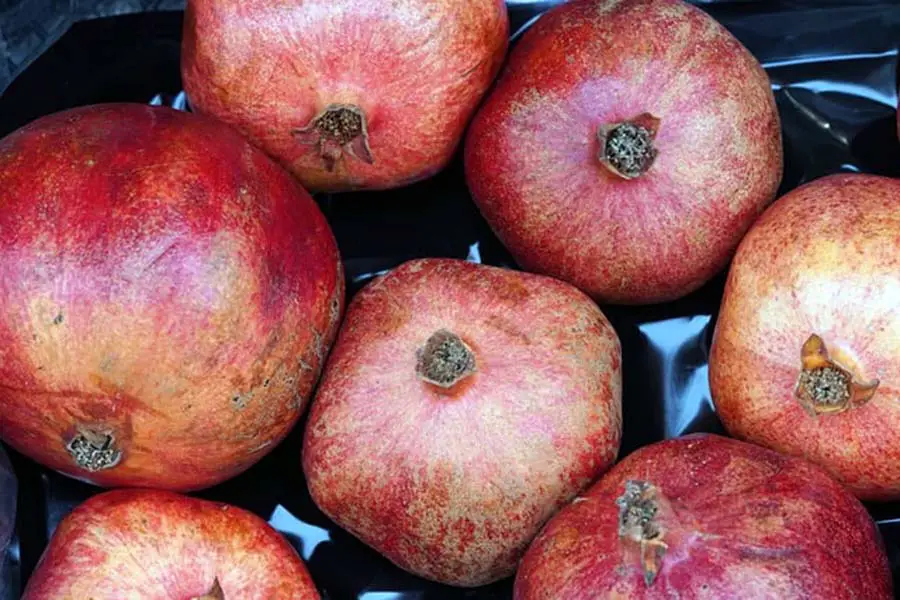
Harvest pomegranates when they are heavy for their size, which indicates that the arils are full of juice. The skin should be soft, leathery, and somewhat stretched-looking. Try a “scratch” test – lightly scratch the surface of the skin with a fingernail. If it scratches easily, the pomegranate might be ready to pick. Younger pomegranates have thick, smooth skin that wont’ scratch easily.
Also, the shape of a ripe pomegranate becomes less perfectly round. As the inside flesh expands, pressure exerted on the rind changes the shape of the fruit. Ripe pomegranates have a hexagonal shape, with the top and bottom of the fruit being somewhat flat.
Learn more tips and tricks for harvesting pomegranates at their sweetest: Picking Perfect Pomegranates: How to Know It’s Harvest Time
Let the Tree Mature
A young pomegranate tree won’t fruit right away – usually it takes 2 to 3 years before the first fruits develop. But those early pomegranates probably won’t taste great. As the tree continues to mature, the pomegranates will become sweeter and more flavorful.
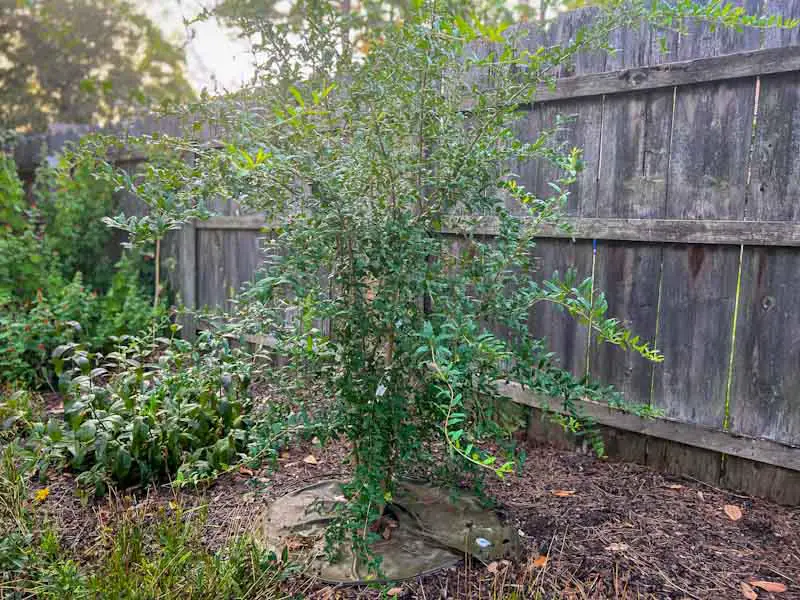
Young trees just don’t have the nutrient-holding capacity to support much fruit growth. The first pomegranates will likely taste tart and be less juicy. Each year the fruit will become more and more flavorful. If your tree is young, just wait a year or two. The pomegranates will get sweeter as the tree matures.
At a certain point (after about 25 years), a pomegranate tree starts to become less fruitful. Pomegranate production may slow down, and the fruits themselves will start to decrease in quality. If delicious fruit is your goal, it may be time to replace a pomegranate tree that’s past its prime.
Related: The Lifespan of a Pomegranate Tree (Decades of Fruit!)
Plant a Sweeter Pomegranate Variety
It may just be that the pomegranate cultivar naturally grows fruit that is more tart than sweet. Certain varieties are known for a (pleasant, in my opinion) acidity, but not a ton of sweetness to balance it.
One solution is to plant a second pomegranate variety that grows a sweet-forward pomegranate. These sweet fruits may taste less pomegranate-like without the characteristic acidity, but they are still delicious.
When the fruits are ripe, cut open and remove the arils from each type of pomegranate. Combine the tart seeds with the sweet ones, and you have a perfectly balanced snack.
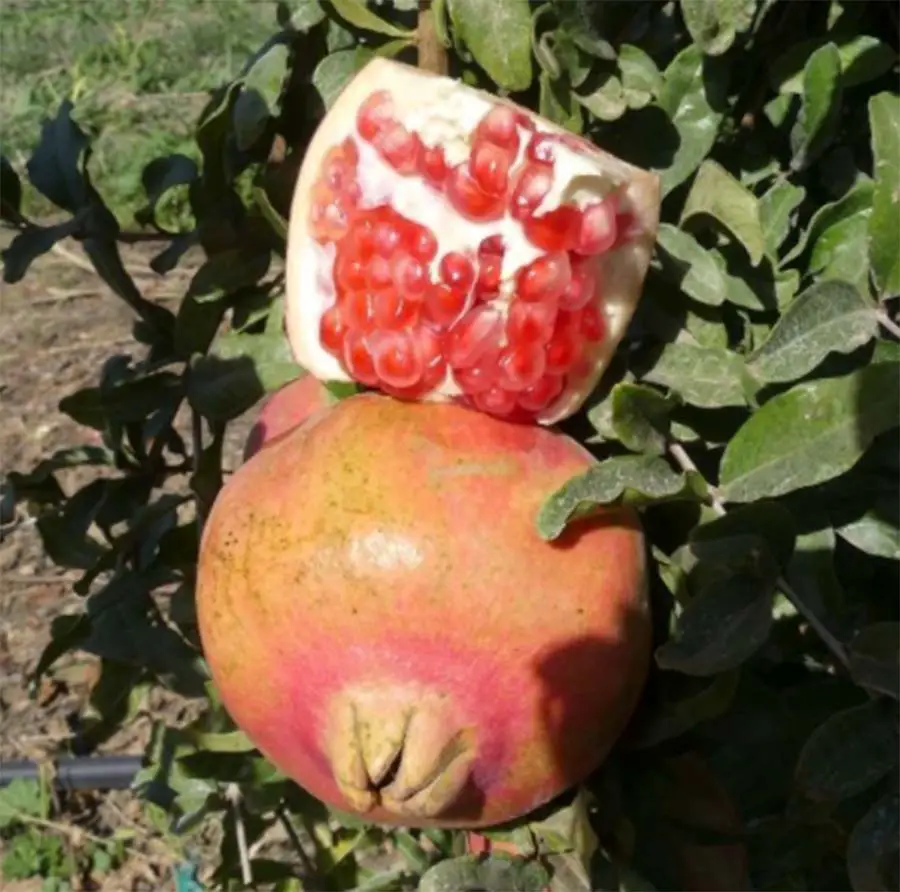
A few popular sweet pomegranate varieties include ‘Eversweet‘, ‘Pink Satin’, and ‘Purple Heart’.
Learn more details about sweet pomegranate varieties, plus a lot of other fun cultivars here: Choosing the Perfect Pomegranate Tree (19 Top Varieties)
How to Sweeten a Tart Pomegranate
If all else fails, and you find yourself with overly tart pomegranates, simply add some sugar and salt to make the fruit more palatable.
Salt works wonders to neutralize the sour flavor of tart fruit (try this method with sour blackberries next time). And the sugar, of course, adds the missing sweetness.
Harvest the pomegranate arils and put them into a bowl. Sprinkle a teaspoon or two of sugar and a generous pinch of salt over them. Stir, and let it sit for about 15 minutes to allow the salt and sugar to dissolve and combine with the pomegranate arils. Then dig in and enjoy!

